Simulation of the Spectrum Response for the THz Atmosphere Limb Sounder (TALIS)
Abstract
1. Introduction
2. Instrument Characteristics
3. Simulation Model of the TALIS Spectrometer
3.1. Generating Radiance by ARTS
3.2. TALIS Simulation Model
- Step 1:
- Generating 11 bands of the radiance spectrum from 10 to 90 km through ARTS;
- Step 2:
- Modeling the thermal noise signal of hot and cold targets by Equation (2), and modeling the scene target signal by Equation (4). The system noise of each frequency band is shown in Table 1, and the scene target radiance spectrum is obtained from Step 1;
- Step 3:
- Modeling the frontend output signals corresponding to the hot and cold targets and the scene targets, respectively, through Equation (5);
- Step 4:
- The process of backend quantization and power spectral density (PSD) calculation is represented by Equations (6) and (7), respectively. In addition, by averaging 400,000 PSD, the PSD with the expected integration time of 100 ms can be obtained.
4. Simulation Results of the TALIS Instrument Performance
4.1. Calibration
4.2. Imbalance between Two DSB Sidebands
4.3. Spectrum Resolution
4.4. Quantization Error
5. Conclusions
Author Contributions
Funding
Acknowledgments
Conflicts of Interest
References
- Satoshi, O.; Philippe, B.; Toshiyuki, N. SMILES-2 Mission for Temperature, Wind, and Composition in the Whole Atmosphere. Sci. Online Lett. Atmos. 2017, 13, 13–18. [Google Scholar]
- Wang, W.Y.; Wang, Z.Z.; Duan, Y.Q. Performance Evaluation of THz Atmospheric Limb Sounder (TALIS) of China. Atmos. Meas. Tech. 2020, 13, 13–38. [Google Scholar] [CrossRef]
- Wu, D.L.; Read, W.G.; Shippony, Z.; Leblanc, T.; Duck, T.J.; Ortland, D.A.; Sica, R.J.; Argall, P.S.; Oberheide, J.; Hauchecorne, A.; et al. Mesospheric temperature from UARS MLS: Retrieval and validation. J. Atmos. Sol. Terr. Phys. 2003, 65, 245–267. [Google Scholar] [CrossRef]
- Waters, J.W.; Peckham, G.E. The Microwave Limb Sounder (MLS) Experiments For UARS And EOS. In Proceedings of the IGARSS’91 Remote Sensing: Global Monitoring for Earth Management, Espoo, Finland, 3–6 June 1991. [Google Scholar]
- Waters, J.W.; Read, W.G.; Froidevaux, L.; Jarnot, R.F.; Cofield, R.E.; Flower, D.A.; Filipiak, M.J. The UARS and EOS Microwave Limb Sounder (MLS) Experiments. J. Atmos. Sci. 1999, 56, 194–218. [Google Scholar] [CrossRef]
- Barath, F.T.; Chavez, M.C.; Cofield, R.E.; Flower, D.A.; Frerking, M.A.; Gram, M.B.; Wilson, W.J. The Upper Atmosphere Research Satellite microwave limb sounder instrument. J. Geophys. Res. 1993, 98, 10751. [Google Scholar] [CrossRef]
- Lay, R.R.; Lee, K.A.; Holden, J.R.; Oswald, J.E.; Jarnot, R.F.; Pickett, H.M.; Shoemaker, C.M. On orbit commissioning of the Earth observing system microwave limb sounder (EOS MLS) on the Aura spacecraft. Earth Obs. Syst. X 2005, 5882. [Google Scholar] [CrossRef]
- Schoeberl, M.R.; Douglass, A.R.; Hilsenrath, E. Overview of the EOS Aura mission. IEEE Trans. Geosci. Remote Sens. 2006, 44, 1066–1074. [Google Scholar] [CrossRef]
- Waters, J.W.; Froidevaux, L.; Harwood, R.S.; Jarnot, R.F.; Pickett, H.M.; Read, W.G.; Walch, M.J. The Earth observing system microwave limb sounder (EOS MLS) on the aura Satellite. IEEE Trans. Geosci. Remote Sens. 2006, 44, 1075–1092. [Google Scholar] [CrossRef]
- Ala-Laurinaho, J.; Hirvonen, T.; Piironen, P.; Lehto, A.; Tuovinen, J.; Raisanen, A.V.; Frisk, U. Measurement of the Odin telescope at 119 GHz with a hologram-type CATR. IEEE Trans. Antennas Propag. 2001, 49, 1264–1270. [Google Scholar] [CrossRef]
- Murtagh, D.; Frisk, U.; Merino, F.; Ridal, M.; Jonsson, A.; Stegman, J.; Oikarinen, L. An overview of the Odin atmospheric mission. Can. J. Phys. 2002, 80, 309–319. [Google Scholar] [CrossRef]
- Frisk, U.; Hagström, M.; AlaLaurinaho, J.; Andersson, S.; Berges, J.-C.; Chabaud, J.-P.; Dahlgren, M.; Emrich, A.; Florén, H.-G.; Florin, G.; et al. The Odin satellite—I. Radiometer design and test. Astron. Astrophys. 2003, 402, 27–34. [Google Scholar] [CrossRef]
- Olberg, M.; Frisk, U.; Lecacheux, A.; Olofsson, A.O.H.; Baron, P.; Bergman, P.; Florin, G.; Hjalmarson, Å.; Larsson, B.; Murtagh, D.; et al. The Odin satellite: II. Radiometer data processing and calibration. Astron. Astrophys. 2003, 402, 35–38. [Google Scholar] [CrossRef]
- Seta, M.; Masuko, H.; Manabe, T. 643 GHz SIS Receiver System for JEM/SMILES on International Space Station. In Proceedings of the Tenth International Symposium on Space THz Technology, Charlottesville, VA, USA, 16–18 March 1999. [Google Scholar]
- Ozeki, H.; Inatani, J.; Satoh, R.; Nishibori, T.; Ikeda, N.; Fujii, Y. Development of superconducting submillimeter-wave limb-emission sounder (JEM/SMILES) aboard the International Space Station. Proc. SPIE Int. Soc. Opt. Eng. 2002, 4540. [Google Scholar] [CrossRef]
- Ochiai, S.; Kikuchi, K.; Nishibori, T.; Hiroyuki, O.; Kazuo, M.; Fumiaki, O. Performance of JEM/SMILES in Orbit. In Proceedings of the 21st International Symposium on Space Terahertz Technology, Oxford, UK, 23–25 March 2010; pp. 179–184. [Google Scholar]
- Seta, M.; Murk, A.; Manabe, T. Quasi-Optics for 643 GHz SIS Receiver of International-Space-Station-Borne Limb-Emission Sounder SMILES. In Proceedings of the Fourteenth International Symposium on Space THz Technology, Tucson, AZ, USA, 22–24 April 2003; p. 217. [Google Scholar]
- Inatani, J.; Ozeki, H.; Satoh, R.; Nishibori, T. Submillimeter limb-emission sounder JEM/SMILES aboard the Space Station. Proc. SPIE Int. Soc. Opt. Eng. 2000, 4152, 243–254. [Google Scholar]
- De Lange, G.; Birk, M.; Boersma, D.; Dercksen, J.; Dmitriev, P.; Ermakov, A.B.; Khudchenko, A.V. Development and characterization of the superconducting integrated receiver channel of the TELIS atmospheric sounder. Supercond. Sci. Technol. 2010, 23, 045016. [Google Scholar] [CrossRef]
- Muller, S.C.; Murk, A.; Monstein, C.; Kampfer, N. Intercomparison of digital fast Fourier transform and acoustooptical spectrometers for microwave radiometry of the atmosphere. IEEE Trans. Geosci. Remote Sens. 2009, 47, 2233–2239. [Google Scholar] [CrossRef]
- Nishibori, T.; Sato, R.; Kikuchi, K. Composition of the Atmosphere from Mid-EarthOrbit (CAMEO). J. Inst. Electron. Inf. Commun. Eng. 2008, 108, 123–128. [Google Scholar]
- Manago, N.; Ozeki, H.; Suzuki, M. Band selection study for the sub-mm limb sounder, SMILES-2. In Proceedings of the 2014 IEEE Geoscience and Remote Sensing Symposium, Quebec City, QC, Canada, 13–18 July 2014; pp. 4153–4156. [Google Scholar]
- Suzuki, M.; Manago, N.; Ozeki, H. Sensitivity study of SMILES-2 for chemical species. In Sensors Systems and Next-Generation Satellites XIX; International Society for Optics and Photonics: Bellingham, WA, USA, 2015. [Google Scholar]
- Baron, P.; Murtagh, D.; Eriksson, P.; Mendrok, J.; Ochiai, S.; Pérot, K.; Sagawa, H.; Suzuki, M. Simulation study for the Stratospheric Inferred Winds (SIW) sub-millimeter limb sounder. Atmos. Meas. Tech. 2018, 11, 4545–4566. [Google Scholar] [CrossRef]
- Nathaniel, J.; Livesey, W.; Van, S.; William, G.R.; Paul, A.W. Retrieval Algorithms for the EOS Microwave Limb Sounder (MLS). IEEE Trans. Geosci. Remote Sens. 2006, 44, 1144–1155. [Google Scholar]
- Benz, A.O.; Grigis, P.C.; Hungerbühler, V.; Meyer, H.; Monstein, C.; Stuber, B.; Zardet, D. A broadband FFT spectrometer for radio and millimeter astronomy. Astron. Astrophys. 2005, 442, 767–773. [Google Scholar] [CrossRef][Green Version]
- Buehler, S.A.; Eriksson, P.; Kuhn, T.; von Engeln, A.; Verdes, C. ARTS, the atmospheric radiative transfer simulator. J. Quant. Spectrosc. Radiat. Transf. 2005, 91, 65–93. [Google Scholar] [CrossRef]
- Duan, Y.Q.; Wang, Z.Z.; Wang, W.Y.; Xiao, Y.W. Simulating microwave humidity and temperature sounder onboard Fengyun 3D satellite. IEEE Trans. Instrum. Meas. 2019. accepted. [Google Scholar]
- Klein, B.; Hochgürtel, S.; Krämer, I.; Bell, A.; Meyer, K.; Güsten, R. High-resolution wide-band Fast Fourier Transform spectrometers. Astron. Astrophys. 2012, 542, L3. [Google Scholar] [CrossRef]
- Jarnot, R.F.; Waters, J.W.; Peckham, G.E. Calibration of the Microwave Limb Sounder on the Upper Atmosphere Research Satellite. In Proceedings of the IGARSS ’94—1994 IEEE International Geoscience and Remote Sensing Symposium, Pasadena, CA, USA, 8–12 August 1994. [Google Scholar]
- Robert, F.J.; Vincent, S.P.; Michael, J.S. Radiometric and Spectral Performance and Calibration of the GHz Bands of EOS MLS. IEEE Trans. Geosci. Remote Sens. 2006, 44, 1108–1112. [Google Scholar]
- Wang, Z.Z.; Li, J.Y.; He, J.Y.; Zhang, S.W.; Gu, S.Y.; Li, Y.; He, B.Y. Performance Analysis of Microwave Humidity and Temperature Sounder Onboard the FY-3D Satellite From Prelaunch Multiangle Calibration Data in Thermal/Vacuum Test. IEEE Trans. Geosci. Remote Sens. 2018, 57, 1664–1683. [Google Scholar] [CrossRef]
- Klein, B.; Philipp, S.D.; Güsten, R.; Krämer, I.; Samtleben, D. A new generation of spectrometers for radio astronomy: Fast Fourier transform spectrometer. Millim. Submillim. Detect. Instrum. Astron. III 2016, 627511. [Google Scholar] [CrossRef]
- Belgacem, M.; Ravera, L.; Caux, E.; Caïs, P.; Cros, A. The High Resolution Spectrometer of HIFI Onboard HSO. Proc. SPIE Int. Soc. Opt. Eng. 2004, 9, 43–50. [Google Scholar]
- Bowers, F.K.; Klingler, R.J. Quantization noise of correlation spectrometers. Astron. Astrophys. Suppl. 1974, 15, 373–380. [Google Scholar]
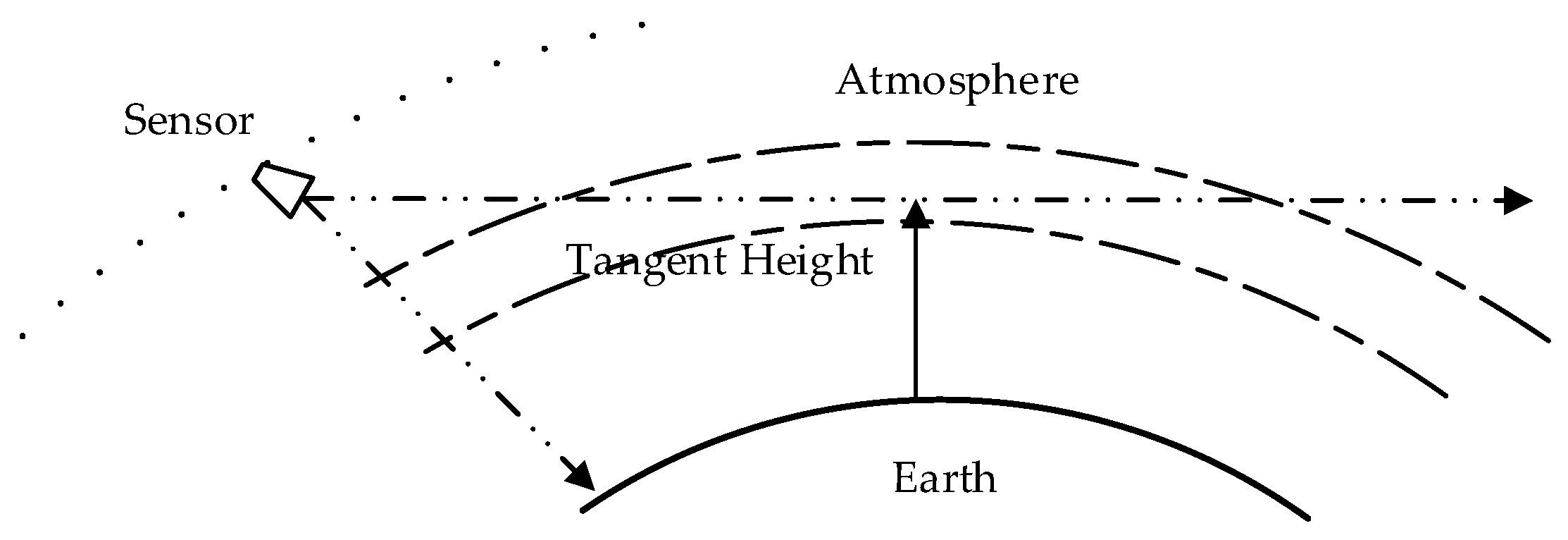










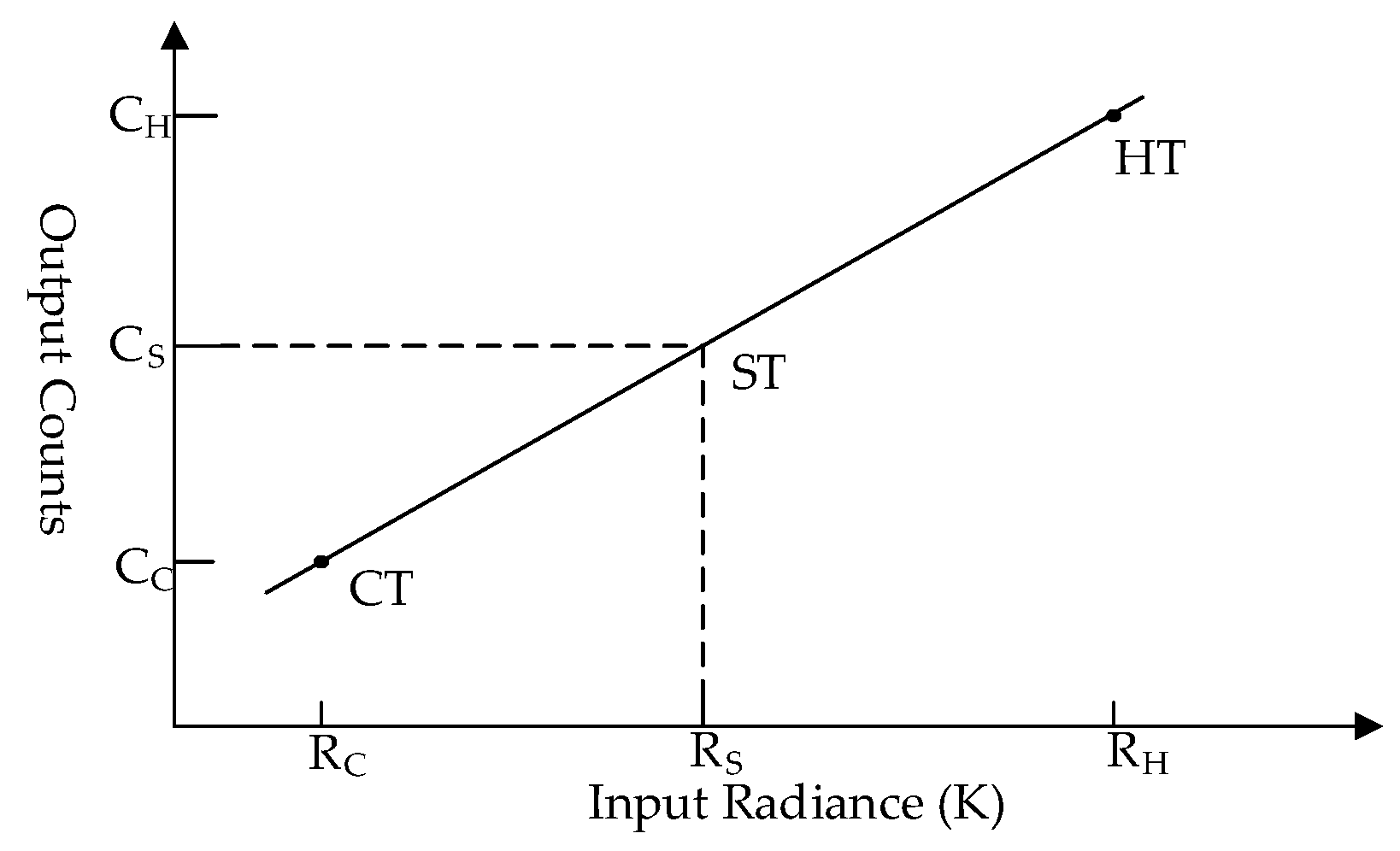

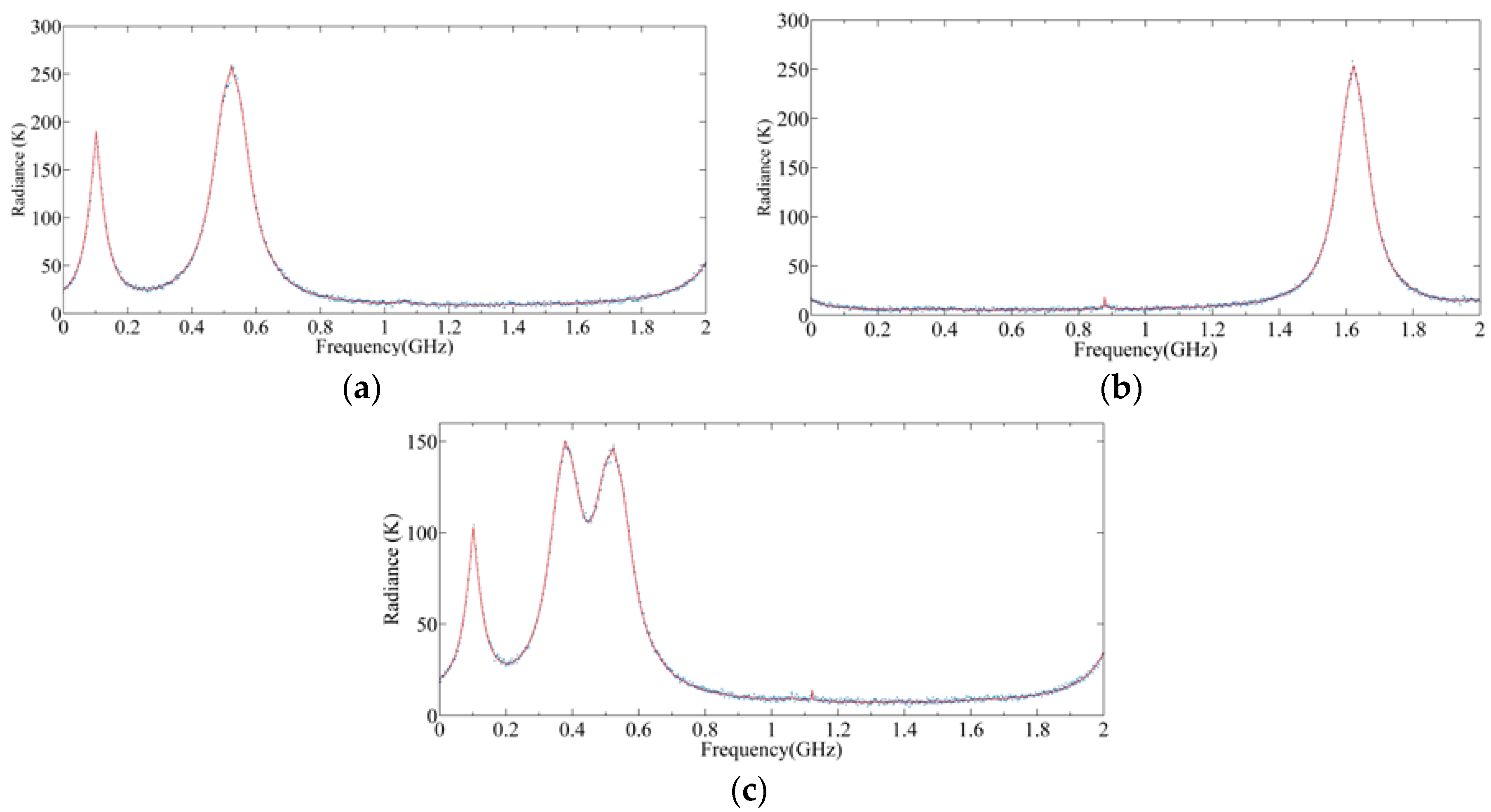



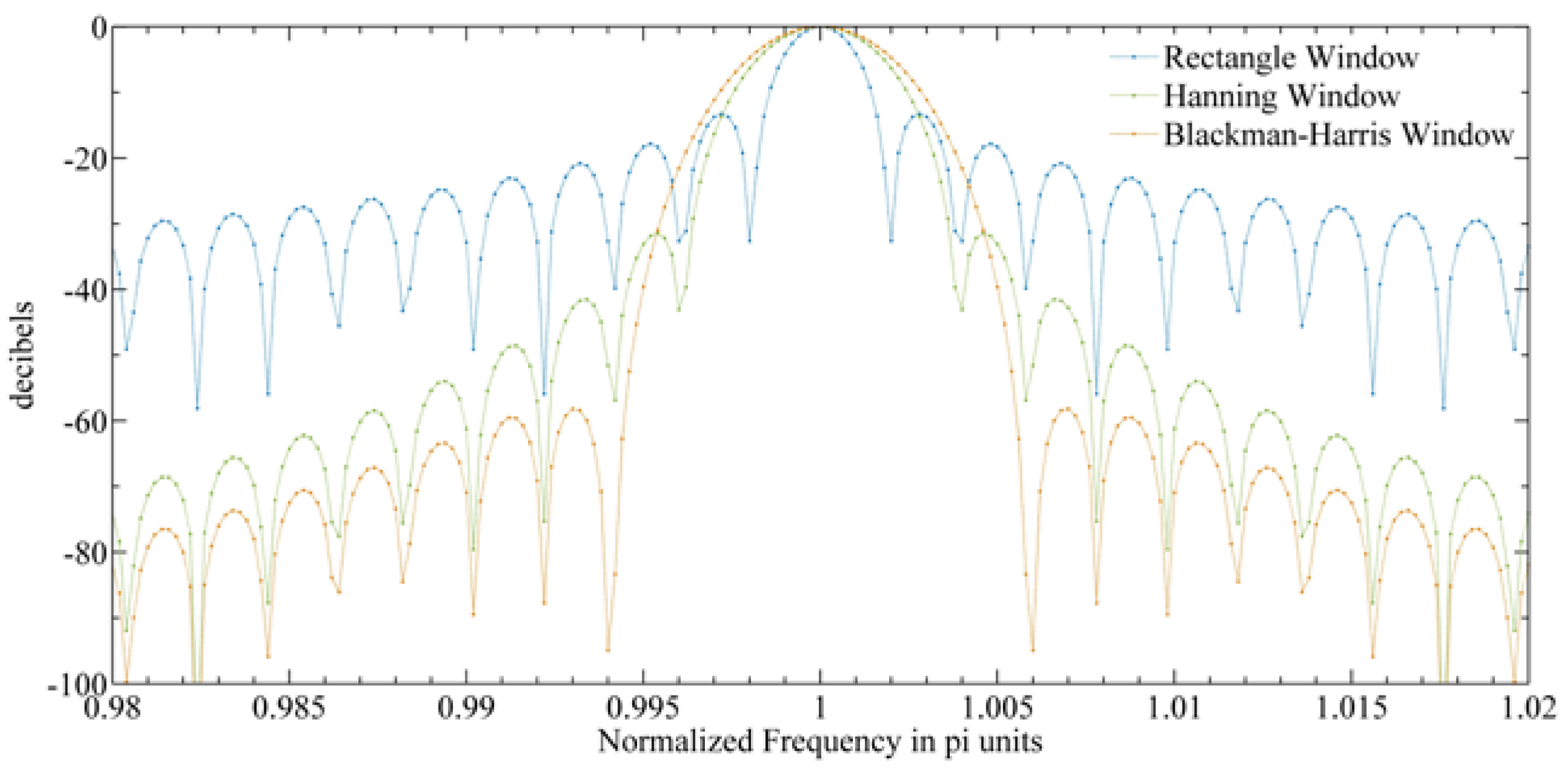
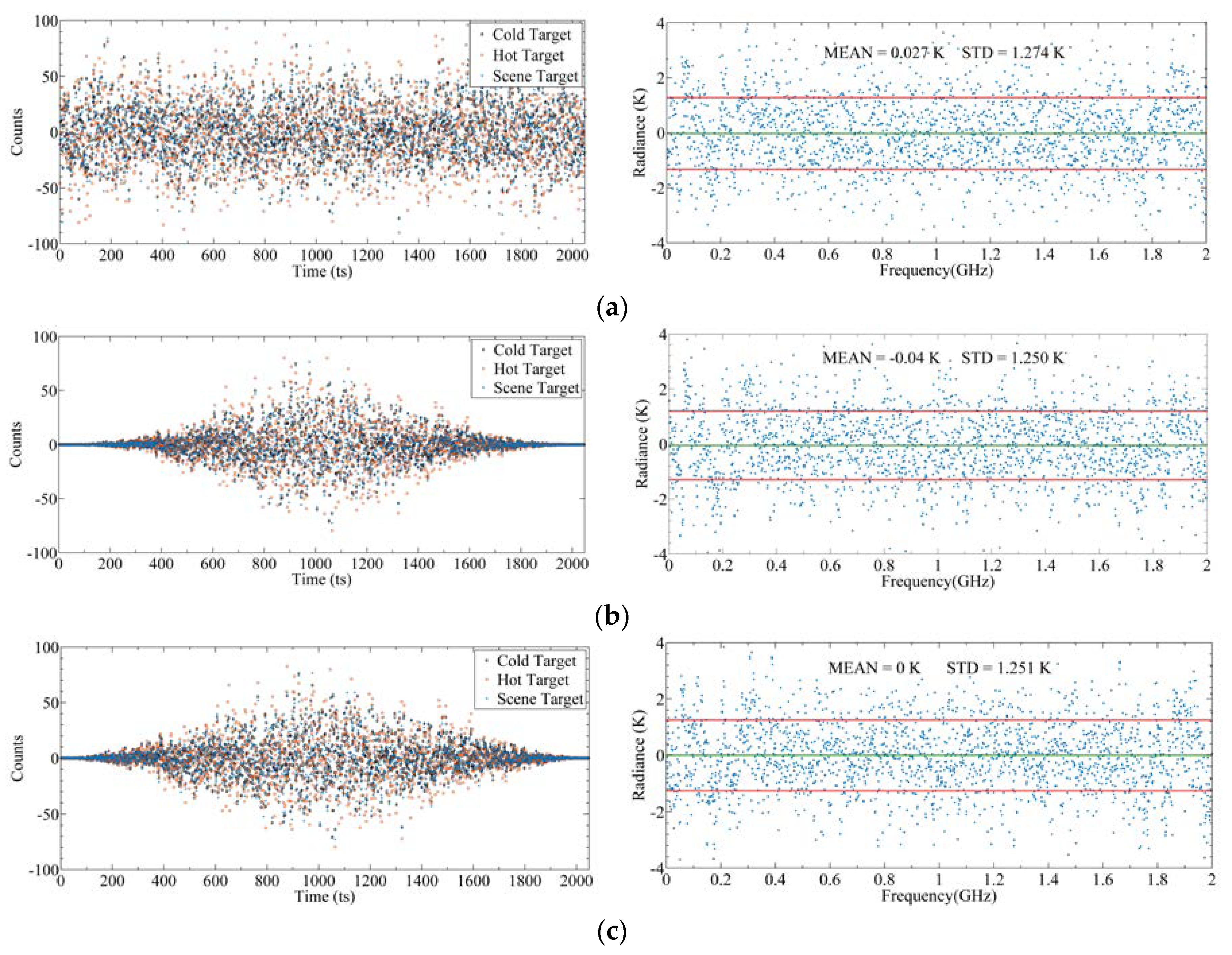

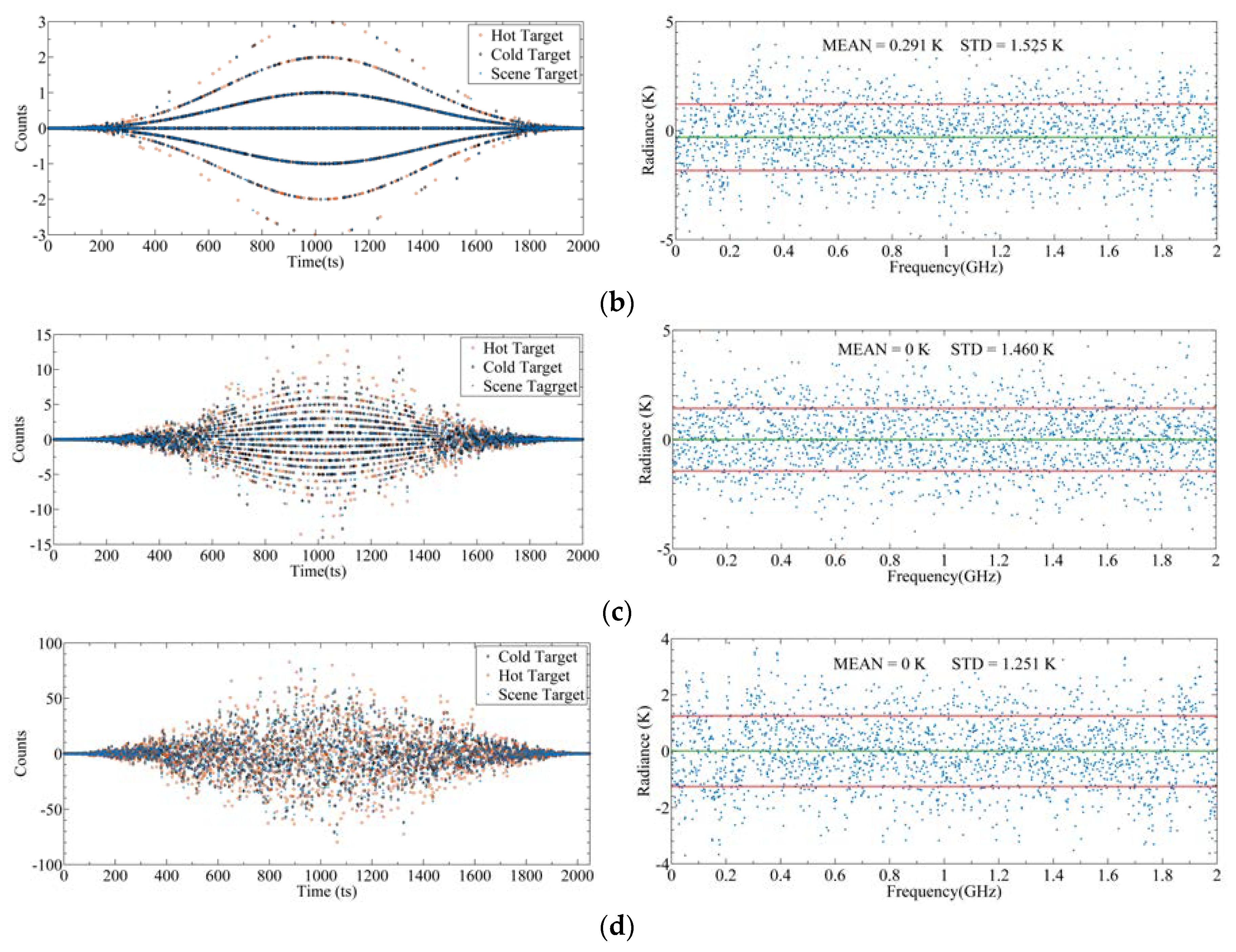
| Band (Local Oscillator (LO)) (GHz) | Tsys (K) | Spectrometer | Band (GHz) | Sensitivity (K) | Main Products |
|---|---|---|---|---|---|
| 118 (117.55) | 1000 | S1 | 115.35–117.35 117.75–119.75 | 2.2 | O2 |
| 190 (190.10) | 1000 | S2 | 175.5–177.5 202.7–204.7 | 2.2 | O3 HCN |
| S3 | 178.9–180.9 199.3–201.3 | N2O ClO | |||
| S4 | 183.0–185.0 195.2–197.2 | O3 H2O | |||
| 240 (239.66) | 1000 | S5 | 229.66–231.66 247.66–249.66 | 2.2 | O3 CO |
| S6 | 232.16–234.16 245.16–247.16 | O3 O2 | |||
| S7 | 234.66–236.66 242.66–244.66 | O3 | |||
| 643 (642.87) | 2300 | S8 | 624.47–626.47 659.27–661.27 | 5.1 | ClO BrO HO2 |
| S9 | 627.37–629.37 656.37–658.37 | HNO3 | |||
| S10 | 632.37–634.37 651.37–653.37 | N2O | |||
| S11 | 624.47–626.47 659.27–661.27 | HCl BrO |
| Integration Time (ms) | Theoretical Value (K) | Simulated Value (K) | ||
|---|---|---|---|---|
| Means | STD | Means | STD | |
| 1 | 0 | 11.18 | 0.018 | 11.82 |
| 10 | 0 | 3.54 | 0.027 | 3.87 |
| 100 | 0 | 1.12 | −0.015 | 1.25 |
| Quantization Level | FFT Spectrometer | Autocorrelation Spectrometer |
|---|---|---|
| 3 | 1.267 | 1.235 |
| 5 | 1.213 | 1.205 |
| 8 | 1.039 | - |
© 2020 by the authors. Licensee MDPI, Basel, Switzerland. This article is an open access article distributed under the terms and conditions of the Creative Commons Attribution (CC BY) license (http://creativecommons.org/licenses/by/4.0/).
Share and Cite
Duan, Y.; Wang, Z.; Xu, H.; Wang, W. Simulation of the Spectrum Response for the THz Atmosphere Limb Sounder (TALIS). Sensors 2020, 20, 498. https://doi.org/10.3390/s20020498
Duan Y, Wang Z, Xu H, Wang W. Simulation of the Spectrum Response for the THz Atmosphere Limb Sounder (TALIS). Sensors. 2020; 20(2):498. https://doi.org/10.3390/s20020498
Chicago/Turabian StyleDuan, Yongqiang, Zhenzhan Wang, Haowen Xu, and Wenyu Wang. 2020. "Simulation of the Spectrum Response for the THz Atmosphere Limb Sounder (TALIS)" Sensors 20, no. 2: 498. https://doi.org/10.3390/s20020498
APA StyleDuan, Y., Wang, Z., Xu, H., & Wang, W. (2020). Simulation of the Spectrum Response for the THz Atmosphere Limb Sounder (TALIS). Sensors, 20(2), 498. https://doi.org/10.3390/s20020498





